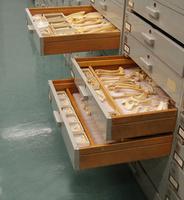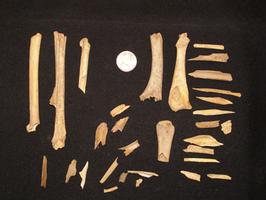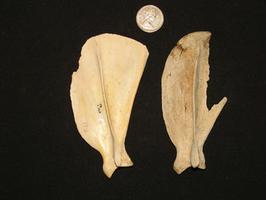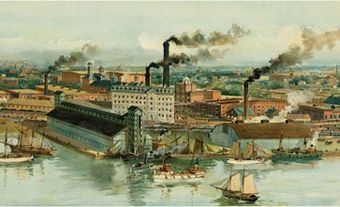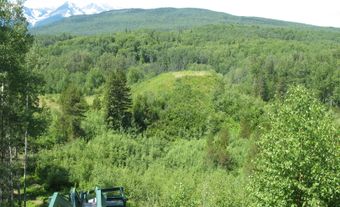Zooarchaeology
Zooarchaeology is the study of animal remains from archaeological sites, and is taught in university departments of archaeology and anthropology in most provinces. Zooarchaeologists are employed as university and college professors, in government and museums, and in consulting companies that specialize in archaeological and environmental research.
In Canada most zooarchaeologists study teeth, bone and marine shells, because these materials are commonly preserved on archaeological sites. Preservation of specimens depends on what happened to them before burial, the rate at which they were buried, and the burial environment. Many processes destroy specimens before they can be buried. For example, dogs scavenge bones, and climatic phenomena, such as wetting and drying, can weather and destroy them. Specimens that become buried can also be destroyed. In Canada there is generally poor preservation of bone and shell in acidic soils formed under coniferous forests, or in shallow sediments, such as those found on exposed prairies. However, good preservation occurs in river silts, slopewash (ie, soil and rock material that has been moved down a slope by gravity assisted by running water), shell middens and cave sites, and zooarchaeological research has been conducted in most parts of the country.
Most archaeological sites in Canada date after the major period of extinctions at the end of the last ice age (see glaciation), so most specimens can be identified by comparing them with collections of modern animal skeletons, housed in universities and museums. Sometimes specimens can be identified to species, but because closely related species have very similar skeletons, many identifications are made to the genus or family level. Some zooarchaeologists analyse ancient DNA to check identifications. Other data recorded include the part of the skeleton (eg, right femur), the portion (eg, proximal end), and any cultural or natural modification (eg, burning, weathering). More specialized information is recorded for a subset of specimens, such as description of the wear on teeth, or measurements that allow male and female to be distinguished.
Zooarchaeological specimens provide information on what people ate in the past. For example, we know that bison were important for 10 000 years on the prairies, and that salmon did not become a staple on the Northwest Coast until about 8000 years ago. Animal remains provide information about changing environments and about human impact on the environment, data that are relevant to modern conservation biology. For example, animal remains from Fur Trade period sites in northeastern BC have shown that passenger pigeons once ranged this far west, and also that the fur traders changed the structure of large mammal populations in the northern Rockies.
In many cultures animals are also important culturally. Food carries important social and symbolic meanings, as do items made from animals, such as bone tools, fur clothing and decorative feathers. The oldest evidence for symbolic behaviour in Canada comes from BC where 10 000 year old Raven burials were excavated. However, ritual use and treatment of animals has been found in many regions, and testifies to the important role that animals played in the consciousness of First Nations people.

 Share on Facebook
Share on Facebook Share on X
Share on X Share by Email
Share by Email Share on Google Classroom
Share on Google Classroom

